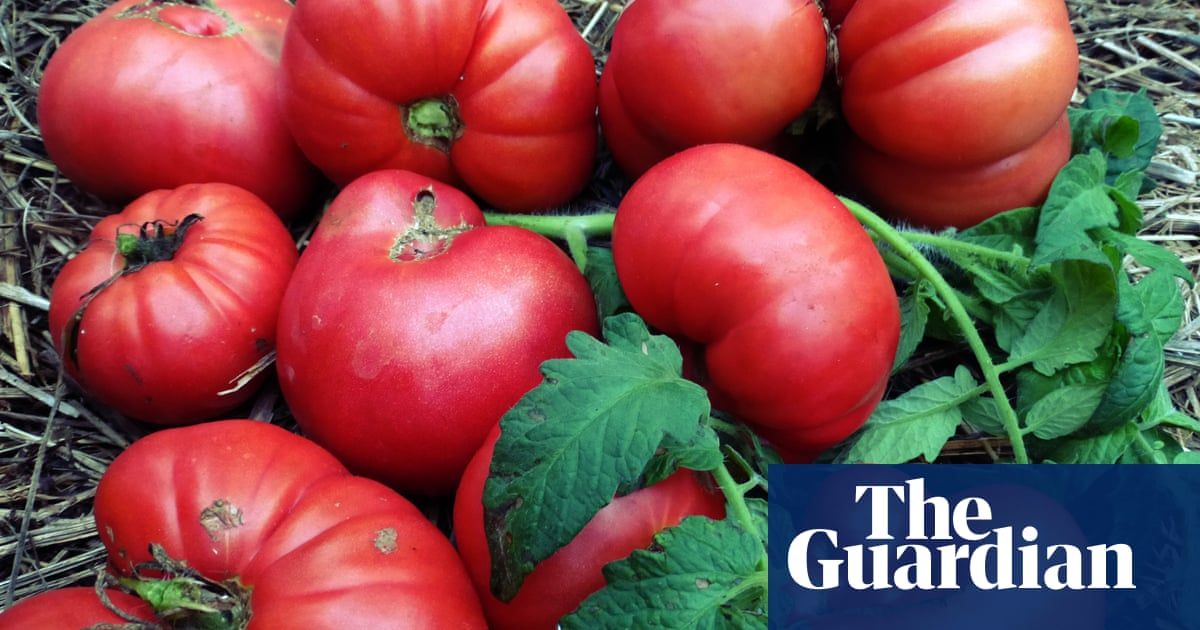Did this tomato travel the Underground Railroad?
The oral history of Aunt Lou’s Underground Railroad tomato could easily fit on an index card, with room to spare. As the story goes, a Black man entered Ohio from bordering Kentucky. No details about when he made this journey are available, but it may have been during slavery or well after emancipation. His travels took him to Ripley, a town that slavery’s proponents characterized as infested with that most odious species: abolitionists. While there, he gave tomato seeds he’d been carrying to a white woman. Years later, her great-nephew, Francis Parker, began sharing the seeds for what had become “Aunt Lou’s tomato” with fellow gardening enthusiasts. Passed from person to person, the seed spread in the small corner of Kentucky and south-west Ohio connected by the Ohio River, a region known for Underground Railroad stops from which runaway enslaved people were secretly ferried to free states.
At some point, the Kentucky tomato guru Gary Millwood proposed a revision of the plant’s name to fellow seed keepers who knew of the variety. Millwood, who was white, suggested adding the “Underground Railroad” part to reflect the anti-slavery activity in the plant’s apparent home ground, and to acknowledge how enslaved people helped build the nation’s agricultural wealth in captivity. Despite centuries of forced farming that transitioned into sharecropping and other exploitative labor systems, few plants bear the names of the Black Americans who stewarded flora and fauna in fields and provisioning grounds. Black workers tilled the land, but white Americans have typically gotten credit for importing, breeding and cultivating crops that became critical to the US diet and economy. Millwood’s move cemented the pinkish beefsteak tomato’s place in history as one of the few vegetable varieties whose name references, however obliquely, slavery or Black contributions to what we grow and eat.
Aunt Lou’s Underground Railroad tomato illustrates the difficulty of constructing a more inclusive and accurate historical record. Documenting the lives of African Americans, who were denied in slavery three things that make people more “trackable” – surnames, property ownership and literacy – often leads to a maddeningly long list of dead ends. Still, an ever-expanding host of farmers, seed keepers and historians have dedicated their work to excavating, whenever possible, how Black Americans stewarded and preserved plants.
Amirah Mitchell, one such excavator, is the founder of Sistah Seeds, a farm that grows and sells seeds of cultural import to African diasporic communities. Among the seeds she offers are the large, curvy cushaw squash that her North Carolina ancestors grew; a Caribbean tomato that may have been carried to the US by migrants fleeing the Haitian Revolution; and a fish pepper collected by the early 20th-century folk artist Horace Pippin. After seeing the Aunt Lou’s Underground Railroad tomato in the Southern Exposure Seed Exchange database, Mitchell added it to the inventory of Truelove Seeds, a company that partners with 50 farms nationwide to produce seeds. She appreciates the hard-to-find, often flat and creasy tomato for its lower acidity, prolific fruit production that can make trellises sag under the weight, and how it makes a substantial slab for a sandwich. Squirrels also seemed to have a special hunger for them, she added. Even though the Underground Railroad tomato’s story is far from complete, “the Aunt Lou story is more fleshed out than most of the others we have,” she said. “Some seeds I steward have way less detail. It is really striking how few have that explicitly stated connection to diaspora, even though they are our heritage.”
The connections between a common vegetable and slavery may not be obvious, but the global slave trade trafficked in plants as well as people. Slave ships carried yams and peanuts as food for the captives. Tough grasses from Africa, which functioned as bedding in the fetid quarters of the vessels, took root in coastal South Carolina (and now are having a rebirth as highly desirable and durable golf-course turf). Some enslavers sought people from West Africa’s “Rice Coast”, including present-day Senegal and Sierra Leone, for their specific expertise with the crop, in hopes of firmly and profitably ensconcing that grain on the American continent. And when Africans landed in the Americas, they engaged with new plants, translated indigenous knowledge into their new lives, and became the most important and involuntary farming workforce in the Americas.
From a home atop a hilltop near Ripley, Ohio, abolitionist John Rankin would watch for the movements of slave hunters and hang a lantern to signal to runaway enslaved people the coast was clear. Photograph: New York Public Library
In the worlds of plant biology and zoology, the person who breeds, “discovers” or introduces a variety or species often gets to name it. But as enslaved people were classified as property themselves, they had no claims to intellectual property. Perhaps the most famous example is a Louisiana man named Antoine, who did what no one else could do in the 1840s: graft a pecan tree. His work ensured the successful reproduction of the trees, spawned scores of varieties, and established a business that thrives to this day; the United States produced about $490m worth of the crop in 2022, according to the US Department of Agriculture. Antoine’s work was displayed decades later in a national expo, and his pecan variety was named Centennial after the event.
At least that story has a name attached to it. An 1863 encyclopedia of fruits and vegetables listed a watermelon with this note: “This remarkably large melon originated with a negro man on the property of Col. [Adam Summer], of South Carolina,” the owner of Ravenscroft Plantation. Like the unknown man who landed in Ripley, Ohio, this man’s status as an enslaved or free person is a mystery. Free people were a tiny sliver of the South Carolina population pre-1865, but a small enclave lived very close to Ravenscroft in Newberry County. For growing an almost 60lb specimen, Summer’s friend, Milton Odell, got the props and the produce named after him. But the South Carolina-based scholar James Kibler, who studies the horticultural heritage of the Summers family plantations, disputes that notion: “Milton Odell didn’t develop that watermelon,” he told me. “And neither did Adam Summer. It was just a chance freak watermelon that a Black gentleman had enough sense to say, ‘My God!’ and took it to Adam. That’s probably close to the story.” For her part, Mitchell offers this plant’s seeds on her website, but she intentionally avoids the Odell moniker in favor of “large, white watermelon”. She’s searching for a better way to identify the plant for people who’ve heard about it and to reflect its origin.
Christopher Bolden Newsome, a co-owner of Truelove Seeds with his husband, Owen Taylor, told me there needs to be a concerted effort to research the roots of plants. Rather than resting on a claim that a modern-day explorer uncovered an unusual pink-striped peanut in the Ecuadorian Amazon, Truelove enlisted an Ecuadorian colleague and South American partners to trace it. And trace it they did, back to the Shuar and Achuar Indigenous communities to which Truelove donates some seed proceeds. Newsome observed that that kind of knowledge doesn’t always reside in a book. “The problem with a more literal, letter-based society is that we want to have written proof,” he said. “That is a function of a type of European thinking, If it wasn’t written down, it didn’t happen.” He added that stories are just as important to heirloom plants as the literal seed itself. Descendants might not have the exact origin stories, he said, “but it’s easy to make new ones. The food that the seed produces quickly gets associated with human activities and emotions”: a meal after a milestone, the last seeds planted before losing a family farm.
Like seeds, narratives are dynamic. They grow and travel, sometimes unpredictably. New information can emerge. Stories drop and pick up details. They change in the telling, the listening, the recording and the erosion of time. Taylor constantly thinks about botanical storytelling; he writes all Truelove seed descriptions. He wants to include accurate data, while simultaneously understanding that oral histories are valid, that archival evidence is not necessarily authoritative, and that people yearn for meaning. “There’s a blurry line between powerful metaphor and history,” he told me. “I am not a historian. I like to understand history as much as I can, but there is a hunger for a reclamation of a story of power and liberation.”
An illustration of a runaway enslaved person from 1898. Photograph: New York Public Library
That was the case with Jay Erisman, a Cincinnati distillery owner with a broad interest in heirloom grains and a specific one in Aunt Lou’s Underground Railroad tomato. He felt drawn to the story, and he submitted the tomato to the Ark of Taste, a global listing of endangered or distinctive foods. A hobbyist historian, Erisman tried to trace the Aunt Lou’s Underground Railroad tomato and hit the expected roadblocks. He couldn’t pin down details of the various narratives he’d heard: Did Aunt Lou actually say the man was formerly enslaved? If so, what did that mean: that he’d liberated himself on the Underground Railroad or simply that they’d met after slavery was abolished? “I think naming it this honors really where it came from, not just Francis and Aunt Lou, but the [maybe] enslaved person who delivered it,” Erisman said. “I started developing this image in my mind of how he’s wading across the Ohio River. His possessions are in a bag on top of his head, and it includes these tomato seeds. Whether that was really the case or not, we don’t know.”
In the end, Erisman decided the most valuable thing about Aunt Lou’s Underground Railroad tomato was not the pursuit of truth or sussing out the “real” story. Instead, it was people in different eras engaging in an age-old practice – gifting each other precious seeds, an act of kindness and community.
Source: The Guardian


